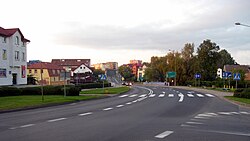Miastko [ˈmʲastkɔ] (Kashubian: Miastkò; German: Rummelsburg),[1] is a town in the Middle Pomerania region of northern Poland, administratively located in the Bytów County in the Pomeranian Voivodeship.
Miastko | |
|---|---|
 Miastko in 2009 | |
| Coordinates: 54°1′N 16°59′E / 54.017°N 16.983°E | |
| Country | |
| Voivodeship | |
| County | Bytów |
| Gmina | Miastko |
| Government | |
| • Mayor | Roman Ramion |
| Area | |
| • Total | 5.68 km2 (2.19 sq mi) |
| Population (2006) | |
| • Total | 10,738 |
| • Density | 1,900/km2 (4,900/sq mi) |
| Postal code | 77–200 |
| Vehicle registration | GBY |
| National roads | |
| Voivodeship roads | |
| Website | http://www.miastko.pl/ |
History
editTraces of human settlement of the Pomeranian and Wielbark cultures and from ancient Roman times and Early Middle Ages were discovered during archaeological excavations in Miastko. The area became part of the emerging Polish state under its first historic ruler Mieszko I in the 10th century. Following the fragmentation of Poland, it formed part of various smaller duchies, including the Duchy of Słupsk from 1368 and Duchy of Pomerania from 1478.
From the 18th century, it was part of the Kingdom of Prussia, within which it belonged to the Province of Pomerania. During World War II, the Polish resistance conducted espionage of German activity in the town.[2] The Germans operated three forced labour subcamps of the Stalag II-B prisoner-of-war camp in the town.[3] In January 1945, a German-perpetrated death march of Allied prisoners-of-war from the Stalag XX-B POW camp passed through the town.[4] On 2 March 1945, it was taken by the Red Army.
In April 1945, a Polish operation group of 22 young men arrived in the town to take over administration of the town, while the German population was largely still present.[5] The Potsdam Agreement confirmed preliminary Polish administration of the region and the native German populace was expelled. According to German reports, in January 1947, Germans to be expelled were collected and had to camp in ruined houses at min 25 degrees minus. British authorities of occupied Germany did not receive the expellees, whoh were interned until March 1947 in various internment camps. Of 2500 Germans of a transport scheduled for January 4 1947, 500 were not to survive the expulsion. [6]
Until 1975, Miastko was a county seat within the Koszalin Voivodeship, and from 1975 to 1998 it was administratively located in the Słupsk Voivodeship.
In 2012 a monument dedicated to the Polish Nation was unveiled in the town park.[7]
Population
edit
|
| |||||||||||||||||||||||||||||||||||||||||||||
| Source: [8][9] | ||||||||||||||||||||||||||||||||||||||||||||||
Transport
editMiastko is located on the intersection of the national roads 20 and 21 and voivodeship road 206. There is also a railway station.
Gallery
edit-
Lake Lednik
-
Park
-
Polish Nation Monument
-
Town hall
Notable residents
edit- Julius Heinrich Franz (1847–1913) a German astronomer
- Tadeusz Sapierzyński (born 1958) a Polish Army officer, former commander of the special forces unit JW GROM
- Krzysztof Gliszczyński (born 1962) a Polish painter
- Ewa Gawryluk (born 1967) a Polish actress
- Wojciech Kałdowski (born 1976) a retired Polish 800 metre runner
International relations
editMiastko is twinned with:
|
|
References
edit- ^ "Miastko". badfallingbostel.de (in German). Retrieved 22 October 2023.
- ^ Encyklopedia konspiracji Wielkopolskiej 1939–1945 (in Polish). Poznań: Instytut Zachodni. 1998. p. 625. ISBN 83-85003-97-5.
- ^ "Les Kommandos". Stalag IIB Hammerstein, Czarne en Pologne (in French). Retrieved 18 October 2024.
- ^ Kaszuba, Sylwia. "Marsz 1945". In Grudziecka, Beata (ed.). Stalag XX B: historia nieopowiedziana (in Polish). Malbork: Muzeum Miasta Malborka. p. 109. ISBN 978-83-950992-2-9.
- ^ Beata Halicka (2016). Polens Wilder Westen: erzwungene Migration und die kulturelle Aneignung des Oderraums 1945-1948. Ferdinand Schöningh. pp. 249–250.
- ^ Die Vertreibung der deutschen Bevölkerung aus den Gebieten östlich der Oder-Neisse. Dokumentation der Vertreibung der Deutschen aus Ost-Mitteleuropa. Vol. I/2. Deutscher Taschenbuchverlag. 1984. pp. 846–850.
- ^ "Pomnik Narodu Polskiego w Miastku odsłonięty (zdjęcia, wideo), "Głos Pomorza"" (in Polish). 3 May 2012. Retrieved June 11, 2019.
- ^ Dokumentacja Geograficzna (in Polish). Vol. 3/4. Warszawa: Instytut Geografii Polskiej Akademii Nauk. 1967. p. 29.
- ^ Słownik geograficzny Królestwa Polskiego i innych krajów słowiańskich, Tom VI (in Polish). Warszawa. 1885. p. 288.
{{cite book}}: CS1 maint: location missing publisher (link)


